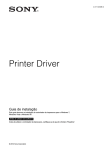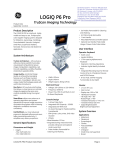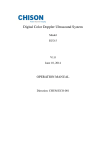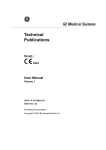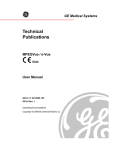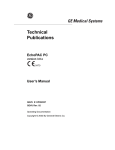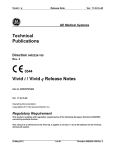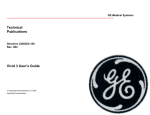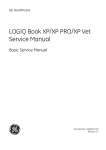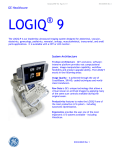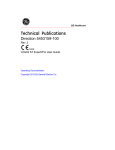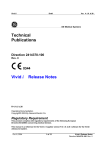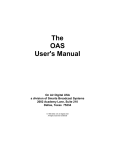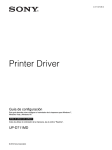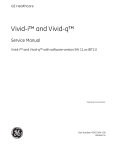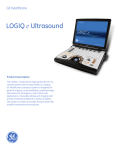Download GE Vivid™ T8 Spec Sheet
Transcript
Vivid T8 ™ General Specifications User Interface Dimensions and Weight Operator Keyboard • Width: - Keyboard: 500 mm (19.7 in) - Caster: 720 mm (28.3 in) • Support for international keyboard character sets • Depth: - Maximum: 810 mm (31.9 in) - Caster: 800 mm (31.5 in) • Interactive back lighting for control panel • Height: - Maximum: 1495 mm (58.9 in) - Minimum: 1410 mm (55.5 in) • Weight: 58 kg, 128 lbs • Ergonomic full size hard key layout • Six TGC pods Touch Screen • 8.4" high-resolution, color, touch screen • Interactive dynamic software menu Electrical Power LCD Monitor • Nominal input voltage: 100-240 VAC, frequency 50/60 Hz • 19" high-resolution LCD • Optional articulating monitor arm The Vivid T8 is our Multipurpose Cardiovascular System designed for reliability in busy environments for cardiac and shared service imaging, with the additional capabilities of 2D, adult, pediatric, fetal/obstetrics, vascular/peripheral vascular, urological, abdominal, transcranial, small parts, musculoskeletal, and transesophageal applications. • Power consumption maximum: 400 VA with peripherals • Optional LCD translation: - +25˚/–90˚ tilt on LCD - Swivel to side viewing direction System Architecture • Optional on-board storage for thermal printer, integrated speakers Product Description Ease of Use features help make the Vivid T8 a productive cardiovascular ultrasound system – simplification of Vivid software and touch panel help make working seamless in any environment. Stress Echo, Auto EF and Scan assist help allow for a productive environment with added efficiency. True Scan Raw Data is GE’s innovative technology that allows for advanced processing on archived images by applying many of the same scan controls and advanced quantitative tools available during the original exam. Console Design • Four active probe ports • Fold down and rotation lock mechanism for transportation • ECG port • Resolution: 1280 x 1024 • Integrated HDD (500G) • Brightness, contrast adjustments • Multiple USB ports • Optional DVD-RW drive • Integrated locking mechanism that provides rolling lock and caster swivel lock • Integrated cable management • Removable air filters • Front and rear handles System Overview Applications (probe dependent) Abdominal, Cardiac (adult and pediatric), Musculo-skeletal (conventional and superficial), Small Organ, Pediatric, Obstetrics/Gyn, Fetal (heart and body), Transesophageal, Peripheral Vascular, Transvaginal, Transrectal, Adult, and Neonatal Cephalic • Optional probe cable tray Scanning Methods • One integrated gel holder • Electronic sector • Six probe holders (two optional, four standard) • Electronic convex • Electronic linear • CW pencil Vivid T8 product datasheet – April 2014 – DOC1509022 Page 1 of 10 Transducer Types System Options • Sector phased array • Curved AMM • Convex array • Blood flow imaging • Linear array • Blood flow imaging with Angio • CW Pencil • B-flow • Endovaginal • Tissue tracking • TEE • TSI Operating Modes • 2D tissue • 2D color flow • 2D angio flow • Color M-mode • Tissue velocity M-mode • Continuous wave Doppler • Tissue M-mode • Pulsed wave Doppler with high PRF • Anatomical M-mode • Curved anatomical M-mode (optional) • Tissue velocity imaging • Tissue tracking (optional) • Tissue synchronization imaging (optional) • Strain imaging • Strain rate imaging • Smart Stress (optional) • AFI • Auto EF • Q-Analysis • LOGIQView • Scan Assist • IMT • DICOM* connectivity • MpegVue/eVue • Selectable alternating modes - B or compound + PW - B + CW - B or compound + CFM/PW - B + CFM + CW • Multi-image (split/quad screen) - Live and/or frozen - Independent cine playback • Paper tray • Timeline display - Independent B (or compound) + PW/CW/M display - Display formats • Probe cable tray • Top/bottom selectable format • LVO contrast • Extra probe holder • Strain imaging (optional) • Flexible arm • Strain rate imaging (optional) Peripheral Options • Tissue Doppler imaging • Simultaneous capability - B + PW - B + CFM/TVI + PW - B + CFM/TVI - B + CFM/Angio/TVI/SRI/TT/SI/TSI - B + M/AMM/CAMM - B + CFM/Angio/TVI/SRI/TT/SI/TSI + M/AMM/CAMM - Real-time duplex or triplex mode - Compound + M/CFM/PW - B + color split screen (simultaneous mode) Display Annotation • Patient name: First, last and middle • LITEON* eUAU108 DVDRW • Blood flow imaging (optional) • Patient ID • UP-D711MD • Blood flow angio flow imaging • Age, sex and birth date • SONY* UPD25 color printer • Hospital name • B/W printer (UP-D897MD) • Date format: Two types selectable - MM/DD/YY, DD/MM/YY (optional) • Smart Stress (optional) • Auto EF (optional) • AFI Automated Function Imaging (optional) • Coded phase inversion LVO contrast (optional) • Compound imaging • HP* 100 printer • 1 TB USB hard drive • Time format: Two types selectable - 24 hours, 12 hours • Three-pedal configurable footswitch • Gestational age from LMP/EDD/GA • ECG kits • Probe name • 8 GB memory stick • Map names • Scan assist (optional) Display Modes • Image archive • Live and stored display format: Full size and split screen, both with thumbnails, for still and cine • Depth scale marker • Review image format: 4 x 3 and thumbnails for still and cine • Image depth • Z scores • Fetal trending • Renal calculations • Probe orientation • Focal zone markers • Zoom depth • On-board report package • MPEGVue (optional) Vivid T8 product datasheet – April 2014 – DOC1509022 Page 2 of 10 • B-mode - Gain - Dynamic range - Imaging frequency - Frame averaging - Gray map - Speckle reduction imaging - UD clarity • M-mode - Gain - Dynamic range - Time scale • Doppler mode - Gain - Angle - Sample volume size and position - Wall filter - Velocity and/or frequency scale - Spectrum inversion • Time scale - PRF - Doppler frequency • Color flow Doppler mode - Frame rate - Frame averaging - Sample volume size - Color scale - Power - Color baseline - Color threshold marker - Color gain - PDI • Spectrum inversion • Doppler • Biopsy guide line and zone Image Storage • Heart rate • On-board database of patient information from past exams • Trackball-driven annotation arrows • Active mode display • Stress protocol parameters • Parameter annotation follow ASE standard • Free text with work library General System Parameters System Setup • Pre-programmable categories • User programmable preset capability with administrator preset protection • Factory default preset data • Languages: English, French, German, Spanish, Italian, Portuguese, Swedish, Danish, Dutch, Norwegian, Japanese, Chinese, Polish, Finnish, Greek, Russian, Hungarian, Slovak, Romanian, Czech, Latvian, Lithuanian, Turkish, Estonian, Korean, Serbian, Bulgarian, Croatian, Indonesian, Slovenian • Reload of archived data sets Connectivity and DICOM • Ethernet network connection • DICOM • Verify • Modality worklist Comprehensive User Manual Available on Board Available through touch panel utility page. User manual and service manual are included on CD with each system. A printed manual is available upon request. • Selectable cine sequence for cine review • Measurements/calculations and annotations on cine playback • Measurement results • Scrolling timeline memory Vivid T8 product datasheet – April 2014 – DOC1509022 • Compare old images with current exam • Customized comment home position • Application name • Power output in dB - Hard drive storage: 500 GB • Store • 210 MB of cine memory • MI: Mechanical Index - DVD storage: -R (4.7 GB) • Body patterns • CINE indicator, image number/frame number • Operator message - CD-RW storage: 700 MB • Print CINE Memory/Image Memory • Displayed acoustic output - TIS: Thermal Index Soft Tissue - TIC: Thermal Index Cranial (Bone) - TIB: Thermal Index Bone • Storage devices: - USB memory stick: 8 GB • User-defined annotations • Acoustic frame rate • Bodymarks: Multiple human and animal types • Storage formats: - DICOM – compressed/uncompressed, single/multi-frame, with/without raw data - “Save As” JPEG, MPEG, AVI • Dual-image cine display • Quad-image cine display • CINE gauge and cine image number display • CINE review loop • CINE review speed • Storage commitment • Modality Performed Procedure Step (MPPS) • Media exchange • Off-network DICOM spooler • Query/Retrieve • Structured reporting – compatible with adult cardiac and vascular • Media store of structured reporting • InSite™ ExC capability for remote service/access EchoPAC™ Connectivity • Connectivity and image review capability of Vivid T8 from EchoPAC PC • EchoPAC PC allows instant access to ultrasound images provided by the system • Three user levels help organize data security requirements Page 3 of 10 Image and Data Management • Exceptional workflow with instant access data management • DICOM-SR standard structured reporting mechanism • Next generation of DICOM Image Format: Raw image DICOM incorporates raw image data information with its data management flexibility into the image communication standard DICOM. Available on the scanner and EchoPAC. • 2D, CFM or TVI data at maximum frame rate may be reviewed by scrolling or by running cine loops (can contain more than 1,000 images for imaging modes) • Image clipboard for stamp-size storage and review of stored images and loops • Built-in patient archive with images/loops, patient information, measurements and reports • Structured findings report tools help support efficient text entries with direct editing of findings text, usability enhancements, new configuration options and conclusion section • User can enter normal values which are then compared to actual measurements • Configurable HTML-based report function • Report templates can be customized on board • ASE-based default text modules (English), user customizable • Internal archive data can be exported to removable image storage through DICOM media • DICOM media – read/write images on DICOM format • Alphanumeric data can be exported in Microsoft* Excel* compatible format • JPEG export for still frames • AVI and MPEG export for cineloops • eVue/MPEGvue - Allows interactive viewing of images, loops or full exams from remote location - Using MPEGvue, exams may be stored onto removable media or on remote networked system together with integrated MPEGvue player for viewing on standard PC Scanning Parameters • Digital beamformer with up to 193,536 effective digital channels • Displayed imaging depth: 0 – 30 cm (probe dependent) • Minimum depth of field: 0 – 2 cm (probe dependent) • Maximum depth of field: 0 – 33 cm (probe dependent) • Continuous dynamic receive focus/continuous dynamic receive aperture • Adjustable dynamic range up to 120 dB • Image reverse: Right/left • Image rotation of 0,° 180° Tissue Imaging General • Variable transmit frequencies for resolution/penetration optimization • Display zoom with zoom area control • Internal hard disk – for storing programs, application defaults, ultrasound images and patient archive • High-Resolution (HR) Zoom – concentrates all image acquisition power into selected Region of Interest (ROI) • All data storage is based on ultrasound raw data, allowing to change gain, baseline, color maps, sweep speeds, etc., for recalled images and loops • Variable contour filtering – for edge enhancement • Depth range up to 30 cm – (probe specific) • Selectable grayscale parameters (availability preset-dependent): Gain, reject, DDP, clarity, dynamic range and compress – can be adjusted in live, digital replay and image clipboard recall • Automatically calculated TGC curves helps reduce operator interaction • Automatically calculated lateral gain 2D Mode • Sector tilt and width control • Frame rate in excess of 1,000 fps, depending on probe, settings and applications • Coded octave imaging with coded phase inversion – GE 3rd generation harmonic tissue imaging providing enhanced lateral and contrast resolution as compared to previous generation GE products. Features help reduce noise, help improve wall definition and axial resolution, making it well suited for a wide variety of patient groups • Confocal imaging – allows for multiple transmit focal zones over range of view and a high vector density, probes dependent • Automatic tissue optimization – single keystroke optimizes immediately and automatically different grayscale settings adjusted for the real time image • UD Clarity and UD Speckle reduce imaging – an advanced image processing technique to help reduce speckle in real time examining the relative difference between neighboring pixel values and determining whether the grayscale variations have a sharp difference, follow a trend, or are random in nature • Variable image width – a reduction either increases frame rate or increases the number of focal zones while maintaining the frame rate – application dependent Vivid T8 product datasheet – April 2014 – DOC1509022 Page 4 of 10 • Multiple-angle compound imaging – multiple co-planar images from different angles combined into a single image in real time to help improve border definition, contrast resolution, and reducing angular dependence of border or edge as compared to previous generation GE products • Selectable horizontal scroll speed: 1, 2, 3, 4, 6, 8, 12, 16 seconds across display • LOGIQView – provides the ability to construct and view a static 2D image with wider field-of-view of a given transducer. This allows viewing and measurements of anatomy that is larger than what would fit in a single image • Curved anatomical M-mode – free (curved) drawing of M-mode generated from the cursor independent from the axial plane • Can be activated from live, digital replay or image clipboard recall • L /R and up/down invert, in live, digital replay or image clipboard recall • Anatomical color and tissue velocity M-mode • Digital replay for retrospective review or automatic looping of images, allowing for adjustment of parameters such as gain, reject, anatomical M-mode, persistence and replay speed • M& A capability • Data dependent processing performs temporal processing which helps reduce random noise but leaves motion of significant tissue structures largely unaffected – can be adjusted even in digital replay • 256 shades of gray • Colorized 2D-mode, user-selectable in real-time, digital replay M-mode • Trackball steers M-mode line available with all imaging probes – max steering angle is probe dependent • Simultaneous real-time 2Dand M-mode • M-mode – image data acquired is combined to give high-quality recording regardless of display scroll speed • Digital replay for retrospective review of spectral data • Several top-bottom formats, side-by-side format and time-motion only format – can be adjusted in live or digital replay • Horizontal scroll can be adjusted in live or digital replay Anatomical M-mode • M-mode cursor can be adjusted at any plane Color Doppler Imaging General • Steerable color Doppler available with all imaging probes – max steering angle is probe dependent • Trackball-controlled ROI • Removal of color map from the tissue during digital replay • Digital replay for retrospective review of color or color M-mode data allowing for adjustment of parameters such as encoding principle, color priority and color gain even on stored data • Color invert – user selectable in live and digital replay • Variable color baseline – user selectable in live and digital replay • Multi-variate color priority function gives delineation of disturbed flows even across bright areas of the 2D-mode image • Color Doppler frequency can be changed independently from 2D Color Flow Imaging • TruSpeed imaging allows either ultra-high frame rate or increased lateral resolution as compared to previous generation GE products • Frame Rate in excess of 150 fps, depending on probe and settings • Variable ROI size in width and depth • User-selectable radial and lateral averaging to help reduce statistical uncertainty in the color velocity and variance estimates • Data Dependent Processing (DDP) performs temporal processing and display smoothing to help reduce loss of transient events of hemodynamic significance • PRF settings – user selectable • Digital replay for retrospective review or automatic looping of color images, allowing for adjustment of parameters such as DDP, encoding principle, baseline shift, color maps, color priority and color gain even on frozen/recalled data • Advanced regression wall filter gives efficient suppression of wall clutter • Application-dependent, multi-variate motion discriminator reduces flash artifacts • For each encoding principle, multiple color maps can be selected in live and digital replay – variance maps available • Application-dependent, multi-variate motion discriminator helps reduce flash artifacts • More than 65,000 simultaneous colors processed, providing a smooth display two-dimensional color maps containing a multitude of color hues • Simultaneous display of grayscale 2D and 2D with color flow • Dedicated coronary flow application Color Angio • Angle-independent mode for visualization of small vessels with enhanced sensitivity compared to standard color flow of previous GE products Vivid T8 product datasheet – April 2014 – DOC1509022 Page 5 of 10 Color M-mode Tissue Velocity Imaging • Variable ROI length and position – user selectable Tissue Velocity Imaging Mode • User-selectable radial averaging to help reduce statistical uncertainty in the color velocity and variance estimates • Selectable horizontal scroll speed: 1, 2, 3, 4, 6, 8, 12, 16 seconds across display – can be adjusted during live, digital replay or image clipboard recall • Real-time 2D image while in color M-mode • Same controls and functions available as in standard 2D color Doppler Anatomical Color M-mode • GE-patented, any plane color M-mode display derived from color Doppler cine loop • Also applicable to tissue velocity imaging • M& A capability B-flow (optional) • B-flow is a digital imaging technique that provides real-time visualization of vascular hemodynamics by directly visualizing blood reflectors and presenting this information in a grayscale display • Use of GE-patented techniques to boost blood echoes, and to help preferentially suppress non-moving tissue signals • B-flow is available for most vascular and shared service applications Blood Flow Imaging (optional) • Combines color Doppler with grayscale speckle imaging • Helps improve delineation of blood flow without bleeding into tissue or vessel wall Blood Flow Angio Imaging (optional) • Combines angio with grayscale speckle imaging Vivid T8 product datasheet – April 2014 – DOC1509022 • Myocardial Doppler imaging with color overlay on tissue image • Tissue Doppler data can be acquired in background during regular 2D imaging • Efficient segment specific TSI time measurements • Immediate bull’s eye report • Automatic calculated TSI synchrony indexes • TSI surface mapping • LV synchronization report template • The velocity of myocardial segments after entire heart cycle can be displayed in one single image • CRT programming protocol • Tissue color overlay can be removed to show just the 2D image, still retaining the tissue velocity information • T issue deformation and rate of deformation are calculated and displayed as real-time, color-coded overlay on the 2D image • Quantitative profiles for TVI, tissue tracking, strain and strain rate can be derived Strain/Strain Rate Mode (optional) Tissue Tracking Mode (optional) • Tissue deformation (strain) is calculated and displayed as real-time, color-coded overlay on the 2D Image • Cine compound calculates and displays cineloops generated from a temporal averaging of multiple consecutive heart cycles • Real-time display of the time integral of TVI for quantitative display of myocardial systolic displacement • Anatomical M-mode and curved anatomical M-mode displays (SI and SRI) • Time markers for valve events derived from any TM mode help simplify understanding of signals in velocity traces or curved anatomical M-mode • Myocardial displacement is calculated and displayed as a color-coded overlay on the grayscale and M-mode image – different colors represent different displacement ranges Tissue Synchronization Imaging Mode (optional) • Parametric imaging which gives information about synchronicity of myocardial motion • Myocardial segments colored according to time to peak velocity, green for early and red for late peak • Waveform trace available to obtain quantitative time to peak measurement from TSI Image • Available in live scanning as well as an offline calculation derived from tissue Doppler data • Additional features in combination with multi-dimensional imaging option • Simultaneous acquisition of tri-plane TSI images covering all standard segments in apical views Spectral Doppler General • Operates in PW, HPRF and CW modes • Trackball steerable Doppler available with all imaging probes – max steering angle is probe dependent • Selectable Doppler frequency for enhanced optimization • High-quality, real-time duplex or triplex operation in all Doppler modes, in PW, and for all velocity settings • Frame rate control for optimized use of acquisition power between spectrum, 2D and color Doppler modes in duplex or triplex modes • Very fast and flexible spectrum analysis with an equivalent DFT rate of 0.2 ms • Dynamic gain compensation for display of flows with varying signal strengths over the cardiac cycle to help improve ease of use Page 6 of 10 • Dynamic reject gives consistent suppression of background – user selectable in real-time, digital replay or image clipboard recall • Digital replay for retrospective review of spectral Doppler data • Several top-bottom formats, side-by-side format and time motion only format – can be adjusted in live or digital replay • Selectable horizontal scroll speed: 1, 2, 3, 4, 5, 6, 8, 12 seconds across display – can be adjusted in live or digital replay • Adjustable spectral Doppler display parameters: Gain, reject, compress, color maps – can be adjusted in live or digital replay • User-adjustable baseline shift – in live, digital replay and image clipboard recall • Adjustable velocity scale • Angle correction with automatic adjustment of velocity scale – in live, digital replay and image clipboard recall • Stereo speakers mounted in the front panel • Display annotations of frequency, mode, scales, Nyquist limit, wall filter setting, angle correction, acoustic power indices • Compound in duplex PW/HPRF Doppler • Automatic HPRF Doppler maintains its sensitivity even for shallow depths and with high PRF’s • Digital velocity tracking Doppler employs processing in range and time for high-quality spectral displays • Adjustable sample volume size of 1-8 mm (probe dependent) • Maximum sample volume depth 30 cm CW Doppler • Highly sensitive steerable CW available with all phased array probes • Tissue Velocity Doppler Vivid T8 product datasheet – April 2014 – DOC1509022 Contrast Imaging (optional) L VO Contrast1 – Enables contrast applications intended for imaging of the left ventricle: 1 Schering developed harmonic imaging for supporting contrast agent imaging. LV contrast (3Sc-RS) enhances delineation of the LV border in combination with ultrasound contrast agents. The new implementation of GE’s Coded Phase Inversion (CPI) provides highresolution detection of contrast in the LV cavity and excellent suppression of myocardial tissue signals. Physiological Traces • Integrated ECG or external ECG lead input • High-resolution display of the ECG trace • User adjustable trace gain/position and trace-invert controls • User pre-settable trace gain/position control • Automatic QRS complex detection with user ability to modify QRS trigger positions Automatic Optimization • Optimize B-mode image to help improve contrast resolution, gain, TGC and grayscale • Auto-spectral optimize – adjustments baseline, PRF (on live image) and angle correction Measurement and Analysis (M& A) • Cardiac calculation package including extensive measurements and display of multiple repeated measurements • Vascular measurements package • Measurements can be labeled seamlessly by using protocols or post assignments • Measurements assignable to protocol capability • Parameter annotation follow ASE standard • Seamless data storage and report creation • User-assignable parameters • Comprehensive set of cardiac measurements and calculations to help assess dimensions, flow properties and other functional parameters of the heart • Comprehensive set of shared service measurements and calculations covering vascular, abdominal, obstetrics and other application areas • Configuration package to set up a customized set and sequence of measurements to use, defining user-defined measurements and changing settings for the factory defined measurements • Vivid stress echo support allowing wall motion scoring and automatic stress level labeling of measurements • Support for measuring on DICOM images • Automatic Doppler trace functionality for use in non-cardiac applications in both live and replay • Worksheet for review, edit and deletion of performed measurements • Reporting support allowing a configurable set of measurements to be shown in the exam report • DICOM SR export of measurement data I ntima Media Thickness (IMT) Measurements (optional) • Automated measurement of IMT rather than measuring the IMT manually • Results representative of a region rather than a single point of a vessel wall • Help reduce examination time by enhancing the procedure in measuring the IMT Z-Scores • Limited implementation of z-scores for a set of predefined pediatric dimension measurements Page 7 of 10 OB/GYN Application Module • OB package for fetal growth analysis containing more than 100 biometry tables • Dedicated OB/GYN reports • Fetal graphical growth charts • 2D strain based data moves into clinical practice • 2D continuous capture stress echo (treadmill stress echo) • Simplified workflow with fully automated ROI tracings (if configured), quick tips and combined display of traces from all segments • Q-Stress protocols (acquire tissue velocity data in background for quantitative analysis) • Growth percentiles Automated Ejection-Fraction Calc • Multi-gestational calculations (up to four) • Automated EF measurement tool based on 2D-speckle tracking algorithm • Programmable OB tables • Expanded worksheets • User-selectable fetal growth parameters based on European, American or Asian methods charts • GYN package for ovary and uterus measurements and reporting • Please refer to the user manual for the full list of measurements and calculations for all applications Quantitative Analysis Package (Q-Analysis) (optional) • Traces for velocity or derived parameters (strain rate, strain, displacement) inside defined regions of interest as function of time • Contrast analysis with traces for grayscale intensity or angio power inside defined regions of interest as function of time, including post processing ECG triggering and curve fitting for wash in/wash out analysis • Curved anatomical M-mode display allowing an M-mode along an arbitrary curve in a 2D image • Integrated into M& A package with worksheet summary Annotations Body Marks • Body mark icons for location and position of probe • Easy selection of body marks from touch panel Text Annotations • Easy selection of text annotations from touch panel Scan Assist (optional) • Customizable automations that assist the user through each step of the scan • Helps enhance consistency and reduce keystrokes • Supports selection of all modes, all measurements and dual annotations • Imaging attributes: Octave, Steer, Dual/Quad screen, Compound, LogiqView, Zoom, Depth, Scale and Baseline • On-line or off-line protocol editor Automated Function Imaging (AFI) • Image acquisition according to predefined protocol templates (optional) • Various factory protocol templates • Parametric imaging tool which gives quantitative data for global and segmental wall motion • User configurable protocol templates • Allows comprehensive assessment at a glance by combining three longitudinal views into one comprehensive bull's eye view • Integrated into M& A package with specialized report templates • Wall motion scoring: Analysis by wall motion in individual myocardial segments Supported Protocol Examinations • 2D pharmacological stress echo • 2D bicycle stress echo • Cardiac resynchronization therapy programming protocols Protocol Examinations May Include • Show reference: Show a reference image from baseline or previous level during acquisition • Smart stress: Automatically set up various scanning parameters (for instance geometry, frequency, gain, etc.) according to same projection on previous level • Scan mode settings: Scan mode may be specified for individual views in the protocol • Preview of store: Show running loops as preview before storing to the examination Continuous Capture • Continuously acquire large amounts of 2D image data, and selection of projection views for analysis afterwards • The entire continuous capture recording may be kept in memory while it is possible to store new images outside the protocol template, or the entire recording can be stored to file • Selection of projection views on EchoPAC when the entire recording is stored to file Safety Conformance The Vivid T8 is: • CE Marked to Council Directive 93/42/EEC on Medical Devices Conforms to the following standards for safety: • IEC 60601-1 Medical electrical equipment – Part 1: General requirements for safety • IEC 60601-1-2 Medial electrical equipment – Part 1-2: General requirements for safety Vivid T8 product datasheet – April 2014 – DOC1509022 Page 8 of 10 • Collateral Standard: Electromagnetic compatibility – requirements and tests EMC Emissions Group 1 Class A device requirements as per CISPR 11 • IEC 60601-2-37 Medical electrical equipment – Part 2-37: Particular requirements for the safety of ultrasonic medical diagnostic and monitoring equipment • ISO 10993-1 Biological evaluation of medical devices – Part 1: Evaluation and testing • EN 62366 Medical devices – Application of usability engineering to medical devices Inputs and Outputs • Composite color video output • S-Video output • VGA output (SXGA resolution) • Audio stereo output • 100BASE-TX ethernet (RJ45) • USB (3x in rear, 3 under keyboard) Virus Protection • To reduce virus vulnerability, Vivid T8 is configured with a minimal set of open ports and with all network services not actively used by the system closed down. This helps to reduce the risk of a virus attack on Vivid T8. • GE is continuously judging the need for additional actions to reduce vulnerability of equipment; this includes vulnerability scanning of our products and evaluation of new security patches for the third-party technology used. Microsoft (and other) security patches that address serious issues with Vivid T8 will be made available to customers after GE verification of those patches. Transducers 3Sc-RS Phased Array Sector Probe • Applications: Cardiac, Cardiac_2, Abdominal, Renal, Cranial, Exercise, Pediatric, LVO Contrast, FAST, FATE • Biopsy Guide: Multi-angle, reusable bracket S-RS Phased Array Probe 6 • Applications: Pediatric, Pediatric_2, Coronary, Neonatal Head, Fetal Heart, Abdominal, Pediatric Abdominal L6-12-RS Linear Array Probe • Applications: Carotid, Thyroid, Breast, LEA, LEV, UEA, UEV, Musculoskeletal, Musculoskeletal Superficial, Small Parts, Scrotal, Pediatric Abdomen, Pediatric Hip, Neonatal Abdomen, Neonatal Hip 8C-RS Micro Convex Probe • Applications: Pediatric Abdominal, Pediatric Hip, Neonatal Abdominal, Neonatal Head, Vascular • Biopsy Guide: Not available E8C-RS Endo Micro Convex Probe • Applications: Fetal Echo, Follicle, GYN, OB1, Prostate • Biopsy Guide: Fixed-angle, disposable, or reusable bracket 6Tc-RS TEE Probe • Applications: Cardiac, Cardiac_2, Coronary P2D Pencil Probe • Applications: Cardiac • Biopsy guide: Multi-angle, disposable with a reusable bracket 4C-RS Curved Array Probe • Applications: Abdomen, Abdomen 2, Follicle, GYN, OB1, OB23, Pediatric Abdominal, Prostate, Renal • Biopsy guide: Multi-angle, disposable with a reusable bracket probe frequency range catalog # 3Sc-RS 1.3 – 4.0 MHz H45041DL 6S-RS 2.7 – 8.0 MHz H45021RP L6-12-RS 6.0 – 13.0 MHz H48062AC 4C-RS 1.8 – 6.0 MHz H4000SR 8C-RS 4.0 – 11.0 MHz H40402LS E8C-RS 4.0 – 11.0 MHz H40402LN 6Tc-RS 2.9 – 8.0 MHz H45551ZE 2.0 MHz H45551CA P2D Vivid T8 product datasheet – April 2014 – DOC1509022 Page 9 of 10 ©2014 General Electric Company – All rights reserved. April 2014 General Electric Company reserves the right to make changes in specifications and features shown herein, or discontinue the product described at any time without notice or obligation. Contact your GE representative for the most current information. GE, GE Monogram, Vivid, InSite and EchoPAC are trademarks of General Electric Company or one of its subsidiaries. *Third-party trademarks are the property of their respective owners. D ICOM is a trademark of the National Electrical Manufacturers Association. M icrosoft and Excel are trademarks of Microsoft Corporation. HP is a trademark of 2014 Hewlett-Packard Development Company, L.P. LITEON is a trademark of Lite-On IT Corporation. SONY is a trademark of Sony Corporation. GE Medical Systems Ultrasound & Primary Care Diagnostics, LLC, a General Electric Company, doing business as GE Healthcare. About GE Healthcare GE Healthcare provides transformational medical technologies and services to meet the demand for increased access, enhanced quality and more affordable healthcare around the world. GE (NYSE: GE) works on things that matter – great people and technologies taking on tough challenges. From medical imaging, software & IT, patient monitoring and diagnostics to drug discovery, biopharmaceutical manufacturing technologies and performance improvement solutions, GE Healthcare helps medical professionals deliver great healthcare to their patients. GE Healthcare 9900 Innovation Drive Wauwatosa, WI 53226 U.S.A. www.gehealthcare.com DOC1509022










